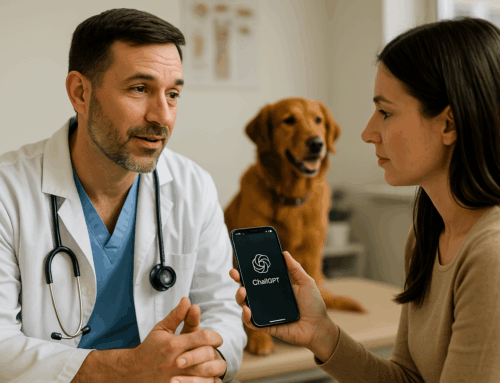“Change is coming, and the curve is logarithmic, not linear.”
That’s how Robert Sanchez summed it up when we contributed to the AI in Companion Animal Veterinary Medicine Report. It’s a 75-page deep dive led by Jon Ayers, with contributions from Dr. Adam Little, Aaron Massecar, Dr. Jane Brunt, David Kincaid, and Robert himself. It’s the clearest look yet at how artificial intelligence is reshaping veterinary medicine, and it should stop every independent practice owner in their tracks.
Veterinary medicine is in the middle of the biggest shift in a century. Costs keep climbing. Clients are showing up more informed than ever. Corporates are tightening their grip. AI won’t slow any of that down—it’ll accelerate it. The good news? Independents who act first have the upper hand.
Here are three shifts you need to be ready for.
1. The End of “Value Before Pricing”
For decades, veterinary pricing has been a black box. Most practices only share fees after the exam, leaving pet owners frustrated and unsure what they’re walking into—largely due to best practices in vet med around showing the “value” of services before bringing up pricing. That’s about to end.
AI tools are already scanning websites and pulling price lists. Soon pet owners will be able to compare practices the same way they shop for flights. Since 2019, veterinary prices have jumped nearly 45 percent while general inflation rose only 26 percent. Pet owners are motivated to shop—and they will, whether you publish your prices or not.
At Digital Empathy, we’re fans of transparency. It builds trust, helps clients plan, and turns price from a “gotcha” into part of your story. But a bare list of numbers isn’t enough. The practices that win will explain why their prices look the way they do. What’s included? What makes your spay different from the low-cost clinic down the street? What can a pet owner expect as a ballpark figure when taking in their sick cat?
A great example: we partnered with Valley Center Veterinary Clinic to create a pricing page. It pairs fees with context, showing the value, safety, and thoroughness behind every service. Independent practices that lean into transparency now will own the conversation before corporates catch on.
2. Clients Become Medical Partners through Contextualized Care
The old model—vets as gatekeepers, clients as passive listeners—is gone. Pet owners are walking in with ChatGPT printouts, notes from online forums, and questions you’d never have heard five years ago. It might feel overwhelming at first, but it doesn’t have to be a threat. It’s a chance to meet clients where they are and show them you’re on their side.
AI is already changing how these conversations unfold. Tools like scribes are giving veterinarians back their full attention in the exam room. Instead of splitting focus between the client, the pet, and the computer, doctors can stay present while AI drafts a complete SOAP note in the background. Many of these systems even generate a plain-language summary for the client — so pet owners leave the appointment with clear instructions and a stronger sense of confidence in the plan.
This context matters. When clients see their own observations reflected back in the record — the subtle changes they noticed at home, the goals they shared for the visit, the anxieties they admitted about their pet’s stress — they feel heard. That simple act transforms the relationship from “doctor and passive client” into “partners making a decision together.”
Practices that lean into this shift will stand out. They’ll be seen not as gatekeepers holding information, but as collaborators who value transparency and trust. And in an era where loyalty is harder to hold onto, that’s the kind of connection that lasts.
3. Independents Can Outpace Corporates
One of the clearest findings from the AI in Companion Animal Veterinary Medicine Report is that corporate groups move slowly. Even IDEXX has acknowledged that independents are faster at adopting new tools. Large organizations need committee approvals, pilots across multiple hospitals, and long rollout timelines. That caution may protect them from risk, but it also leaves them exposed.
Independent practices don’t face that same drag. You don’t need a board vote or a 12-month implementation plan. If you see a tool that makes sense, you can pilot it tomorrow, refine how it works for your team, and fully roll it out within weeks. That agility is your advantage.
AI is shifting the playing field in ways that make speed even more valuable. Transparency tools are exposing price differences in the local market. New client expectations mean that the exam room has to be more collaborative. And AI is lowering the cost of tasks that used to drain hours of staff time. For independents, this is a rare chance to beat corporates at their own game.
Local connection has always been your strongest asset. You know your clients, you know their pets, and you know the community you serve. What AI does is amplify that advantage. By adopting tools like Spotlight to capture client insights before the visit or AI scribes to keep the focus on the pet instead of the keyboard, you can deliver a level of service that corporate chains can’t replicate at scale.
When you pair agility with empathy, you create something powerful: a practice that feels deeply personal and modern at the same time. That’s how independents can thrive in an AI-driven world.
Your 90-Day Plan
You don’t need a five-year roadmap. Here’s what you can put in motion right now to start getting ahead of the AI curve.
1. Publish a Transparent Prices Page
Pet owners are already searching for this information, and if they don’t find it on your site, they’ll find it somewhere else. The key isn’t just posting numbers—it’s telling the story behind them.
- Choose your core services. Start with 8–12 items like exams, spay/neuter, dentals, vaccines, and bloodwork.
- Write in plain language. Say “spay (female dog or cat),” not “OHE.”
- Add context. Explain what’s included and why it matters, like “Our dental cleanings include digital X-rays, anesthesia monitoring, and pain management so your pet is safe and comfortable.”
- Show your value. Make clear what differentiates you from low-cost clinics.
- Partner with us. Digital Empathy can help craft the narrative so pet owners see your pricing as a promise of safety and quality, not just a transaction.
2. Tell the Story Beyond Numbers
Transparency should feel personal, not transactional.
- Add an intro. A short “why we share our prices” statement at the top of your page.
- Answer FAQs. Include simple Q&As like “Why do prices vary between clinics?” or “What’s included in a spay?”
- Use visuals. Simple icons or charts make information easier to understand at a glance.
3. Pilot Spotlight
Spotlight is our intake-to-insight tool that gathers client information before the visit and surfaces red flags for your team.
- Start small. Pilot it with wellness exams or dentals.
- Train in one session. Walk your team through how Spotlight works and what to look for in the flagged insights.
- Track the results. Measure time saved per appointment and client feedback.
4. Test an AI Scribe
Documentation is one of the biggest drains on time and energy. AI scribes solve that.
- Pick one room or one doctor. Keep the pilot simple.
- Compare notes. Check AI-generated SOAP records against your usual process.
- Use client summaries. Hand pet owners a jargon-free summary after their visit to reinforce trust and reduce callbacks.
5. Record a Short Explainer Video
AI search and YouTube are already where pet owners go for answers. A simple video positions you as the trusted source.
- Pick one common question. For example, “Why is a spay more expensive at some clinics?”
- Keep it simple. Record on your phone in good light and speak naturally.
- Post widely. Upload to your website, add to YouTube, and clip it for social media.
None of these steps require a massive budget or six months of planning. They’re small moves that show your clients—and search engines—that your practice is forward-thinking, transparent, and trustworthy. If you want to dig deeper into the data behind these shifts, download the full AI in Companion Animal Veterinary Medicine Report.
The future isn’t waiting. Independents that take the first steps now will thrive in this new landscape.
Ready to think differently about your practice’s growth?
Schedule a 30-minute call with Robert. Or subscribe to our newsletter for future insights straight to your inbox.






Leave A Comment